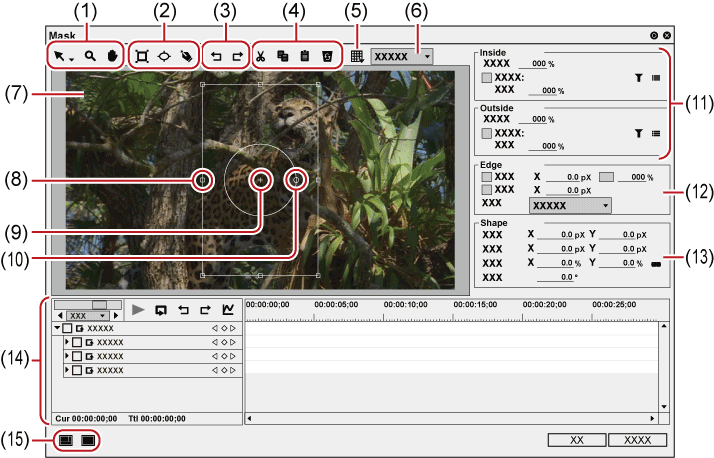You can combine and set multiple video filters to one clip.
User preset effects or system preset effects are also available.
[Mask]
[Chrominance]
[Combine Filters]
[Blend Filters]
This section explains how to apply the mask filter for an example. For other filters, check the filter details in the description in the property, or by trying to apply the filter.
You can apply a video filter to outside and inside of any range. You can also move the mask position in the key frame according to the video.
1) In the folder view of the [Effect] palette, click the [VideoFilters] tree and display the filters.
2) Drag and drop [Mask] to the clip on the timeline.
 Alternative
Alternative
Select a clip on the timeline. Select [Mask] in the [Effect] palette, and click [Add to Timeline].
Select a clip on the timeline. Right-click [Mask] in the [Effect] palette, and click [Add to Timeline].
Select [Mask] in the [Effect] palette, and right-drag it to the clip on the timeline, and click [Add] or [Replace].
3) Display the [Information] palette, and double-click [Mask].
The [Mask] dialog box appears.
4) Configure the mask and click [OK].
Clips with the mask specified are displayed with an orange line.

|
(1) |
Tool buttons |
|
|
(2) |
Drawing buttons |
|
|
(3) |
[Undo]/[Redo] |
|
|
(4) |
Edit buttons |
Cut, copy, paste, and delete a selected path. |
|
(5) |
Function menu |
[Apply Mask] Switch the enable/disable setting for mask temporarily. [Background] Switch the show/hide setting for the transparent grid if the transparency is set for outside and inside of the mask. [Motion Path] Switch the show/hide setting for the path if the position is changed by key frame and the setting is enabled. [Grid] Switch the show/hide setting for the grid. [Guide] Switch the show/hide setting for the underscan, overscan, title safe, horizontal/vertical center line. [Stereoscopic] Displayed only in the stereoscopic edit mode. The display can be switched to L side only, R side only or to the L and R sides blended. |
|
(6) |
Zoom factor |
Change the zoom factor by entering a value or selecting a value from the list. |
|
(7) |
Preview |
Display a preview of the image being edited. Select a path to display a handle or anchor to modify the path. |
|
(8) |
Stretch handles |
Move the cursor to the operation handles at the corners and at the middle of the lines to resize the area. |
|
(9) |
Anchor |
Indicate the reference point of the path. This point is a reference point for the rotation center and for stretching. Drag with [Ctrl] on the keyboard held down to change the position. |
|
(10) |
Rotation handle |
Move the cursor and drag the rotation handle to rotate the image. |
|
(11) |
[Inside]/[Outside] |
Set video filters for outside and inside the path. [Opacity] Use these settings to configure the transparency inside and outside of the path. [Filter] Check this item to enable the video filters set inside and outside the path.
[Strength] The strength of video filter effects can be set. |
|
(12) |
[Edge] |
Use these settings to specify colors and blur to the path. If there are multiple paths, the edge settings are applied to all the paths. Individual setting is not allowed. [Color] Check this item to enable the color edge. Enter an edge width in [Width] in pixels. Click Color box to specify the edge color. Enter the edge transparency in percentage. [Soft] Check this item to blur the edge. Enter a blur width in [Width] in pixels. [Side] Apply the color and soft (blur) widths for outside and inside (or both) the path. |
|
(13) |
[Shape] |
For the selected path, change the various settings including the position by entering a value. You can select multiple paths to change in batch. To select multiple paths, click the paths or drag the mouse with [Shift] on the keyboard held down to enclose the paths. [Anchor] Specify the reference position of the path. With the path center as the origin, specify the anchor position by entering values to X and Y. [Position] Specify the path position. With the frame center as the origin, specify where to place the anchor position by entering values to X and Y. [Scale]
Enter a zoom factor for zoom in and out. Click
[Rotation] Enter an angle to rotate the image. |
|
(14) |
Key frame timeline |
Set a key frame to apply a movement to the mouse position. |
|
(15) |
Window layout |
Toggle the window layouts between [Normal], [Preview], and [Multi]. Select [Preview] to hide the parameters and key frame timeline to enlarge the preview. Select [Multi] for a multi-monitor view. * [Multi] option is not displayed for a single monitor system. |

You can resize the [Mask] dialog box by moving the cursor to a corner or an edge of the dialog box and dragging the mouse when the cursor shape changes. You can also click [Maximize] to maximize the window size.
Move the cursor to the bottom of the preview window and drag the mouse when the cursor shape change to adjust the display area.
Right-click the preview to display a menu to select a tool or change the zoom factor. Right-click and click [Zoom] → [Fit] to fit the frame to the preview window. When you move the frame using the pan tool, right-click the frame and click [Centering] to place the frame to the center.
When the selected path or anchor is dragged while [Shift] on the keyboard held down, it can be moved limiting to X or Y axis.
Double-click the preview to add a key frame on the timeline cursor position when the parameter of the key frame setting is enabled.